Marconi Eras
Weagant’s Anti-Static InventionWeagant’s Anti-Static Invention
Published in The Wireless Age April 1919 Pages 11–20

Wireless Age Cover April 1919
This very technical article describes possibly the most important wireless advance made during WWI. Much of the development work was done by Weagant at the Belmar station, as well as Aldene, NJ and Miami, Fl.
Scientists and engineers such as Dr. Michael Pupin, Ernst Alexanderson and George H. Clark laud Mr. Weagants work.
Protected as a military secret during the war, the invention was disclosed to the press on November 19, 1918. That day the evening papers carried stories such as those below as well as many more. Much of the development work on this invention was done at
The following articles & many many more are on file at Princeton University in the Edward Nally papers
November 19, Inventor finds a way to keep wireless clear, New York Times.
November 19, New Powers for Wireless, NY Evening Sun
November 19, Wireless to be rid of Towers, NY Evening Glode
November 19, New Invention Rids Wireless of Towers, NY Evening Journal
November 19, Navy Used New Radio System Invented Here, NY Evening Mail
November 19, Wireless Without Towers, Invented Here, First Used by U.S. Navy, then by Allies, NY Evening Mail
November 19, Wireless Freed From Static by New Invention, NY Evening Telegram
November 20, NY Sun quote: “Almost everything the Germans sent out breaing on the question of peace was received“
November 20, U.S. Kept Informed, NY Tribune.
Quote: “Through its agency, he said, the U.S. government at Washington, unbeknown to Germany, had learned of nearly all the Teutonic moves and intentions hours before any rumours of them leaked out to the world at large.“
Numerous other articles on file at Princeton
On March 5, 1919 Mr. Weagant shared the technical details to member of the IRE. The result is this article.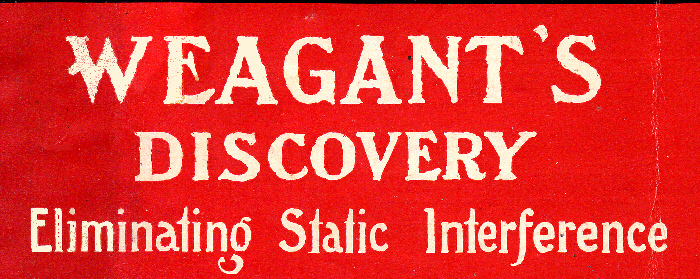
Details of a Great Discovery Which Has Revolutionized Long Distance Wireless Communication
An abstract of a paper read before a joint meeting of the New York Electrical Society and the Institute of Radio Engineers at a monthly meeting, Wednesday, March 5, 1919.
In Two Instalments.
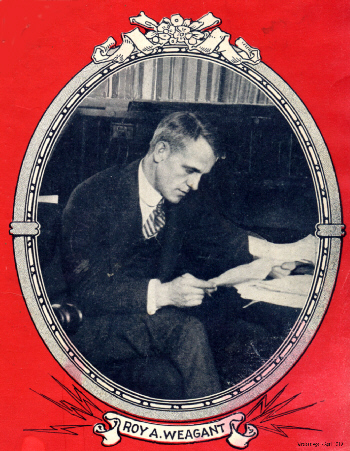 PART I
PART I
Reported by Elmer E. Bucher
Director of Instruction, Marconi Institute
Copyright, 1919, Wireless Press, Inc.
To a large and enthusiastic audience composed of radio engineers and scientists of prominence, at a joint meeting of the Institute of Radio Engineers and the New York Electrical Society, held March 5, 1919, Roy A. Weagant, Chief Engineer of the Marconi Wireless Telegraph Co. of America, delivered a paper describing in detail his apparatus for the elimination of the great bug-bear of transoceanic wireless communication — static interference.
So quiet had the details of Weagant’s great discovery been kept that few in the audience had the slightest inkling of the fundamental principles upon which the operation of his system is based. And so convincing was the explanation given by the speaker that even the most skeptical were compelled to admit that the discovery was not the result of speculation in theory, but was the outcome of a progressive series of orderly, scientific investigations founded on sound scientific principles.
In the subsequent discussion of the paper, one of the first to laud the inventor was Dr. Michael Ivadorsky Pupin, world-famous scientist, who remarked that whatever may be our opinion of the theory advanced supporting a seemingly vertical propagation of static, the outstanding fact remained that Mr. Weagant had demonstrated beyond all doubt that his apparatus was a practical operative proposition and, after all, this was the all-important thing to be considered.
He congratulated the inventor on the success attained and remarked that the discovery was one great stepping stone toward the final solution of the ideal wireless system. He hoped that radio engineers would now give their attention to the development of an amplifier which would permit transoceanic communication with very small powers, for, as he jocularly remarked, the average college professor with his limited pocketbook could not accustom himself to think in terms of 200 kW radio frequency alternators and enormous receiving aerials such as now are employed! He felt, however, that the commercial success of transoceanic communication is now assured.
David Sarnoff, Commercial Manager of the Marconi Company, brought out the fact that for the first time in the history of electrical communication we are enabled to establish a telephonic service between countries separated by the oceans, noting that in some 60 years of the practical applications of electrical signaling, no solution of the problem had even been suggested. He also threw an interesting sidelight on the inventor’s ideas regarding nature and its laws, declaring that Mr. Weagant once remarked that he could not conceive that Mother Nature, having given to mankind such a priceless boon as wireless communication, would deliberately put into force another unsolvable law which would destroy its usefulness. Mr. Weagant had held to this belief firmly, and his subsequent success would seem to indicate that his discovery had initially more of the nature of an inspiration than had ordinary scientific achievements.
G. H. Clark, Expert Radio Aide, U. S. N., who had been assigned to the U. S. Navy Department to witness the experiments of Weagant, testified to the indefatigableness of the inventor, ascribing his success to stubborn persistence and willingness to abandon a mere theory in favor of an experimentally demonstrated fact. He stated that he was amazed at the results secured in the very earliest experiments, which he was privileged to witness, and that, concerning the ability of the Weagant system to weed out static, there could be no doubt.
F. N. Waterman, who has been closely associated with Weagant from the inception of the invention, praised the inventor for his daring in attacking a problem of such magnitude and declared that it was the ability of Weagant to recognize the fallacies of all previous systems purporting to eliminate static that enabled him to evolve a practical method of wireless reception of wonderful, commercial and scientific value. He recounted in a most interesting manner the results of early experiments, and the many obstacles and discouragements met with and overcome.
He stated that after complete success had been attained, it was almost uncanny to pick up a telephone receiver, at a long-distance radio receiving station, in which the crashes of atmospheric electricity were so loud that it was next to impossible to detect the wireless signal, and then to simply throw a switch and note the static disturbances disappear to a degree that required a trained ear to hear them; and simultaneously to note the wireless signal so increased in intensity as to make it easily readable.
E. F. W. Alexanderson, of radiofrequency alternator fame, said that when it was first mentioned that a hitherto unknown law of nature had been uncovered, he was somewhat skeptical regarding it, but now it was plainly to be seen that the speaker of the evening had made a discovery which gave practical results.
Previous to the meeting much speculation had existed regarding the newly observed law of nature disclosed by Weagant’s experiments, and while the speaker plainly asserted that his theory regarding the origin of a particular type of static may yet call for some revision, the reported results of his researches, in a large measure, justified, in the judgment of those present, the belief that Weagant had observed and made practical use of a hitherto unknown static phenomenon.
As a beginning, Mr. Weagant first classified strays after the well-known method of Eccles, pointing out from his observations the distinction between the types that represented genuine obstacles to transoceanic communication and those which caused but occasional interference and. could, therefore, be ignored. Static disturbances due to local lightning and snowstorms were ignored, for the reason that these types are of so infrequent occurrence, as to be of negligible importance; but there remained the three types, termed, “grinders,” “clicks” and “hissing.” The last-named, which are due to an actual discharge from the aerial to the earth, give no trouble in the ungrounded aerials used in the Weagant system. Of the remaining two types, “grinders” and “clicks,” the former were found to constitute the major source of the difficulty.
Experiments
THE static currents induced in a receiving aerial by static “waves” are of the same frequency and of the same damping as the complete receiving system. When the oscillation frequency of the antenna circuit is altered by local tuning, the frequency of the static currents changes in accordance.
For that reason, the differentially connected branched aerial system proposed by Fessenden is ineffective in reducing static; for when one branch is detuned to the wireless signal, static currents of different frequencies exist in the two different branches. Obviously, two currents of opposite phase but of different frequency cannot be made to neutralize one another.
Mr. Weagant’s researches prove that all forms of static eliminators utilizing differentially connected audio or radiofrequency circuits are of little or no value for continuous long-distance wireless reception.
The dominant type of static waves, called “grinders,” apparently is propagated vertically with respect to the earth. Therefore the static “waves” resulting therefrom are at right angles to the wireless waves. By the use of properly dis-posed aerials advantage can be taken of this phenomenon to separate the static and the signal currents.
Two closed-circuit loop antennae, spaced 1/2 wavelength from the center to center, the planes of which are in the path of a passing wave, will be acted upon simultaneously by the vertically propagated static waves, but at different times by the horizontally propagated wireless waves.
Hence, when both loops are correctly coupled to a common receiving set, the static currents will be in phase and may be neutralized. The signal waves will be out of phase and will not neutralize, but will add their E.M.F.’s vectorially.
By proper adjustment of the phases of the currents in one loop, in Weagant’s antennae system, uni-directional reception is possible, signals of maximum intensity being secured from waves arriving at one end of the loops, while interference from the other end of the loops may be annulled.
Underground or surface-ground aerials act as ordinarily closed circuit loops erected above the earth. By reason of the capacity effects between the ends of the aerials and the earth, a return path for the induced currents is afforded, which effectively closes the circuit.
The greater the capacity per unit length between the underground or surface-ground aerial and the true underlying earth, the shorter is the maximum length which can be used to advantage. This accounts for the fact that approximately 2500 feet is the maximum length that can be employed for underground aerials placed under brackish water.
The success of Weagant’s endeavors to eliminate from the receiver the most troublesome forms of atmospheric electricity may be attributed primarily to his clear recognition of the limitations of all so-called static elimination previously evolved.
Take, as an example, the well known receiving circuit in figure 1. His experiments and observations revealed that the static currents induced in the aerial system, A, L-2, L-3, E had the frequency and the damping of the antenna circuit itself, no matter what frequency of oscillation to which it happened to be adjusted. It, therefore, became evident that if one were to separate, by any sort of a device, the static currents in the antenna system from the signal currents, he would be confronted with the proposition of separating two currents of the same frequency in the same circuit.
Experimenters, heretofore, had tried to get rid of static interference by detuning the antenna circuit, by differentially combining two radio frequency receiving circuits, by the differential connection of two detectors of different characteristics, by differentially combining two audio frequency circuits, as in DeGroot’s method, and finally by the use of the Dieckmann shield.
The hoped-for results in detuning the antenna circuit could not be realized because such detuning did not reduce the intensity of the static signal, but simply changed its frequency. The loss, in the transfer of static energy to the secondary circuit when tuned to the frequency of the incoming signal, is exactly the same as the loss in intensity experienced by the signal currents through detuning the antenna. This, of course, does not improve conditions in. the slightest, for it reduces the static and the wireless signal in the same ratio.
Some improvement has resulted from the use of loose couplings between the primary and secondary circuits, provided there is a marked difference between the damping of the signal and static currents; but the relief was by no means sufficient to be of any considerable value when working over great distances.
The “interference preventer” next came in for well-deserved criticism and was proven by Weagant to be ineffective. As many of our readers are aware, Fessenden coupled, differentially, the two legs of a branched aerial, or the primary circuits of two separate aerials, to a common detector circuit as shown in figure 2. He concluded that if one branch, say A, be tuned to a transmitting station and the other branch, B, be detuned, static currents of equal intensity would be induced in both sides and would be annulled, and that, as the signal in one branch had little or no opposition from the other branch, it would be heard. He assumed the static currents to be forced oscillations and, therefore, that their frequency and intensity were unaffected by an amount of detuning that would greatly affect the signal. This, as Weagant clearly pointed out, is an absolute fallacy.
The fact is, that when one branch of the antenna circuit is detuned, the frequency of the static signals changes accordingly, Leaving static currents of one frequency in one branch, and of different frequency in the other branch. It is, obviously, not possible to balance out two opposing E.M.F.’s of different frequencies. Moreover, the detuning of one branch affects the intensity of both the signal and static currents in the secondary circuit in the manner just explained.
It is important to note here that two opposing E.M.F.’s can completely neutralize each other only when they have the same frequency, the same waveform, and the opposite phase. And in the case of damped oscillations, in addition to these requirements, the dampings of the two E.M.F.’s must be identical. The writer feels assured that readers will at once recognize that the steps by which Mr. Weagant eventually arrived at the result attained in his receiving system, constitute one of the most original applications of engineering principles ever made in radiotelegraphy.
Continuing, Mr. Weagant said that if any experimenter had secured worth-while results by means of a differential audio frequency circuit, such results have been due to the looseness of coupling involved in the circuits under test. He pointed out also that the effectiveness of balanced detector circuits is due solely to the protection against loud crashes afforded to the ear of the operator. Regarding the Dieckmann shield and the ability of the combination system to reduce static, as described by De-Groot, the speaker declared that he could see no basis
therein for differentiating between static and signals, and that investigation had proved that the problem of screen-ing out any electromagnetic wave of any sort, either sig-nal or static, cannot be solved by that method.
For experimental observations Mr. Weagant con-structed various forms of aerials, including the horizontal linear-underground and surface-ground aerials. Some of these were found to appreciably reduce static, but the general characteristics of the underground type proved, under experimental investigation, to be entirely different from theories recently advanced. Mr. Weagant’s deduc-tions in respect to this aerial will be stated further on.
In an effort to determine, by means of the Marconi-Bellini-Tosi direction finder (shown in figure 3), whether or not static was horizontally directed; that is, if it originated from any particular direction at certain hours, Mr. C. H. Taylor, a Marconi engineer, carried out a series of experiments at Belmar, N. J., with apparatus designed for the reception of long waves over great distances. Experiments were also carried on by Mr. Weagant, at Belmar,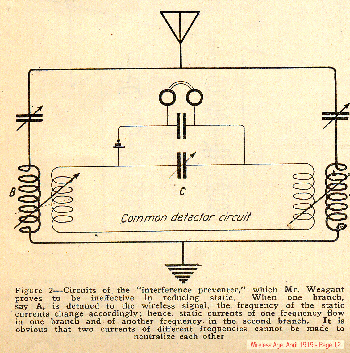
and simultaneously at another station erected at the Marconi factory at Aldene, N. J.
These tests seemed to indicate conclusively that the dominant type of static-“grinders”-apparently came from no definite direction, but gave an equality of disturbances from all points of the compass. A further check on this observation was made by rotating a closed circuit loop (see figure 4) connected to a receiving set, about the vertical axis, A. The loop showed equality of disturbances regardless of the direction of the plane of ‘the loop.
These experiments, as Mr. Weagant said, indicated that if static-.disturbances of the “grinders” type were propagated horizontally, they must come from different directions, and so rapidly that the observer would have no opportunity to manipulate his apparatus with sufficient rapidity enough to determine their direction.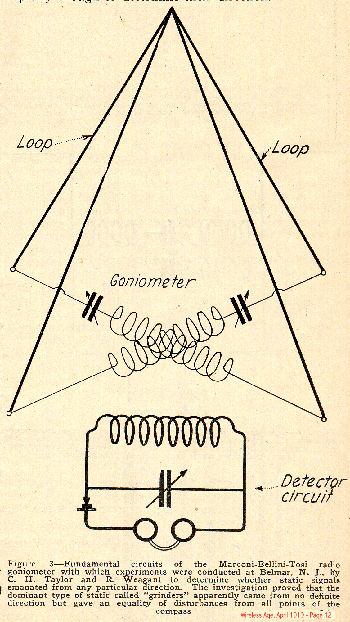
It then occurred to Mr. Weagant that these static disturbances might be propagated vertically, instead of horizontally, and if so the direction of propagation would be at right angles to the direction o f the advancing wireless wave. If that could be definitely proven, then advantage might be taken of the difference in direction to separate the static from the signal currents flowing in the antenna circuit. This was the fundamental working hypothesis on which the Weagant system is based. A series of experiments to verify the hypothesis then followed.
ARE PERPENDICULAR
For one thing, it was found that two loops, the planes of which were perpendicular, were connected to a common receiving apparatus, as in figure 5, the static currents could not be balanced out. The experiment justified the assumption that electromagnetic waves responsible for static currents are heterogeneously polarized; that is, the axes of the oscillators producing them assumed all possible angles in space; and the highly damped waves resulting therefrom are propagated in a direction perpendicular to the earth’s surface. In other words, to the unscientific mind, these static waves may be described as an electric shower which acts upon an aerial, perpendicular to the earth.
To determine the correctness of the hypothesis that static is propagated vertically and to ascertain if it were possible on this assumption to devise a system whereby the static currents could be balanced out while the signal was retained, Mr. Weagant erected at Belmar, N. J., the aerials and apparatus shown in figure 6. Two closed loops A and B, each consisting of a single turn of wire 400 feet high with a baseline of 1,000 feet, were spaced 5,000 feet from center to center. Two wires, brought from each loop to a receiving station located at the center, were supported on ten-foot poles, 6 feet apart. These leads were connected to the primary coils of a goniometer of the type used in direction finders; the secondary coil was connected to a sensitive oscillation detector. It was this apparatus that permitted the reception of transatlantic signals through static interference of great intensity, whereas without it, it was impossible to distinguish the wireless signal.
The connections to the receiving tuner and detector are shown .in figure 6, where loop A has the loading coils L-1 and L-2, the resistances R-1 and R-2, and the coil, L-5, broken at the center point for connection to the variable condenser C-1. The coil L-7 connected to the loop B is similarly connected. Both L-5′ and L-7 are coupled to the secondary coil L-6 which is broken at its center to include the variable. condenser C-2.
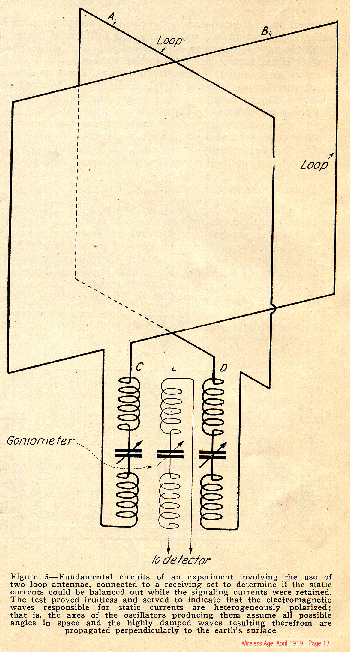
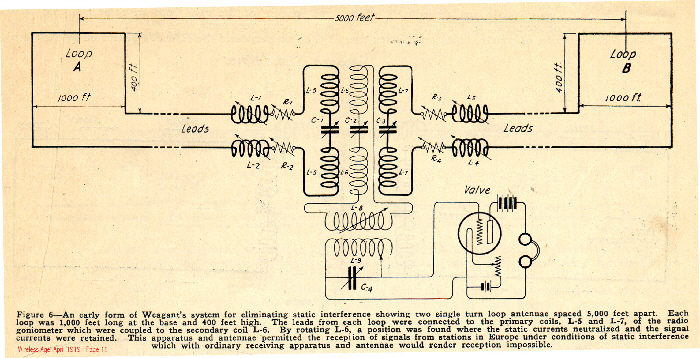
The arrangement of the three coils at the receiving station was. similar to that employed in the Bellini-Tosi goniometer shown in figure 7, wherein the rectangular frames L-5 and L-7 are stationary and the rotating frame L-6 is mounted on a vertical axis so that it can be rotated within the resulting magnetic field.
It may be well to describe here the preliminary procedure of adjustment: The coil L-6 is first placed in inductive relation with L-5 of loop A and the incoming signal tuned to maximum intensity. Next, coil L-6 is placed in inductive relation with L-7 of loop B, which circuit is also tuned to maximum signal intensity. Both loops are then connected in and coupled to the coil L-6 which is turned on its axis to receive the maximum induction from both L-5 and L-7. The two primary coils produce a resultant magnetic field that acts upon the rotating coil somewhat after the principle of the radio goniometer.
An explanatory diagram of the system of figure 6 appears in figure 8. Here the two closed-circuit loops of figure 6 shown as A’ and B’ are coupled to a common secondary coil L-3 of the receiving apparatus which is installed in a station placed between the loops. The vertically propagated static waves are indicated by the downward arrows above the loops and the advancing signal waves which, in this diagram, are assumed to pass from left to right, are represented by the arrows A, A, A, A.
If static waves are propagated vertically, it is clear that they act upon loops A’ and B’ simultaneously and consequently, electro-motive forces of equal intensity are generated in both loops and the static currents resulting therefrom flow in the same direction in each loop, as indicated by the single-pointed arrows. For. purposes of illustration, we have assumed that the static currents flow clockwise in the two loops as shown in the diagram. The current in loop A’ flows downward through the coil L-1 and that in loop B’ upward, through the coil L-2. The two currents will therefore neutralize and consequently, none of the static currents will flow in the coil L-3.
It now remains to be seen how a useful part of the energy of the signal wave is retained. From figure 8 it is evident that the signal wave acts upon the loop A’ before arriving at the loop B’; and we may assume, for the purposes of illustration, that the arrows A represent the progressive movement of the advancing wave. As the wave motion progresses and the positive half acts upon the loop B’, the negative half of the wave is acting upon loop A’. We will assume that, at a particular moment, its polarity is such that in loop A’ the static current and the signal current pass in the same direction through the coil L-1. The signal and static currents must, therefore, flow in opposite directions in the loop B’; and inasmuch as coils L-1 and L-2 are coupled to L-3 in such a way that the static currents oppose and neutralize, the signal currents must build up in phase and accordingly affect the oscillation detector connected to the terminals of the coil L-3. The principle, of course, holds good when the negative half of the signal wave acts upon B’, and the positive half on A’. 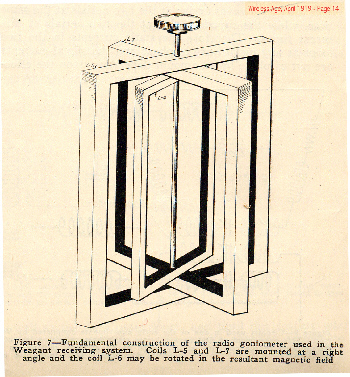
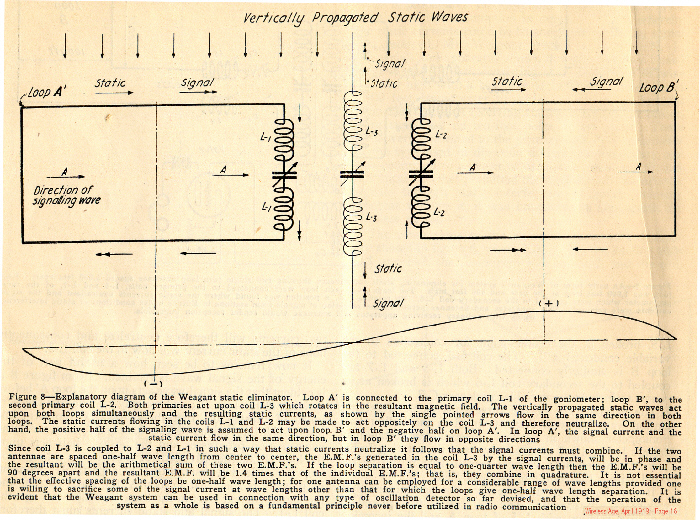
The foregoing may be stated in another way by saying that the static waves arrive at the two aerials at the same time, while the signals arrive at the two aerials at different times. Therefore the static currents in the two loops at any instant are in phase and the signal currents are out of phase by an amount depending upon the effective spacing of the two loops with respect to the wavelength being received.
The magnitude of the E.M.F: s generated by the signal waves will always give a resultant depending, upon the effective separation of the loops; that is, the distance from center to center of the loops. If this separation is the one-half wavelength, the E.M.F.’s generated in the coil L-3 by the signal currents from loops A’ and B’ will be in phase and the resultant is therefore equal to the arithmetical sum of these two E.M.F.’s. If the loop separation is equal to one-quarter wavelength, then the E.M.F.’s acting on the coil L-3 will be 90 degrees apart and the
resultant would be equal to 1.4 times that of the individual E.M.F.’s; that is, they combine in quadrature.
It is clear that the most effective separation for maximum signals is the one-half wavelength, and, therefore, from any particular wavelength, the effective spacing of the loops should be selected to meet the above-mentioned conditions. This, however, is not strictly essential in practice. One antenna can be employed for a considerable range of wavelengths provided one is willing to sacrifice some of the signal currents at wavelengths other than that for which the loops give one-half wavelength separation. This, therefore, is not an objection to the commercial application of this discovery.
Now, if the theory advanced by Mr. Weagant concerning the vertical propagation of static waves were not correct, the results described could not be secured; for, if the apparatus in the receiving station was adjusted so that the signal currents combined vectorially and in accordance with the effective aerial separation, then the static currents would combine similarly, and therefore, the entire system would show the same signal to static ratio as a single loop. Since the experiments proved that the static currents do not combine but are annulled, while the signal is retained, the theory of vertical propagation of static waves is well sustained. However, as Mr. Weagant remarked, if this theory is not correct, it is at least certain that the static waves operate on a sufficient area of both loops, simultaneously, to produce the desired balance described.
In accordance with the principle of the invention, the two loops should preferably be symmetrical in every respect. Controlling appliances permitting proper adjustments to be obtained are shown in figure 6. They consist of the loading inductances, condensers, and variable resistances therein indicated.
Some practical results obtained with the system portrayed in figure 6 were reported as follows: Signals were received at Belmar, N. J., from Nauen, Germany, 6,000and 12,000 meters; Clifton, Ireland, 5,600 meters; Carnarvon, Wales, 14,000 meters; Elivese, Germany, 9,600 meters; and Glace Bay, Nova Scotia, 7,600 meters.Mr. Weagant observed that whenever the circuits were so adjusted that static disturbances were canceled or reduced to a minimum, the signals received on the two loops combined, as might be expected from the spacing between them and the wavelength of the incoming signal.
It is evident that the spacing between the loops in the diagram of figure 6 is slightly over one-quarter wavelength for the wave of 6,000 meters used by Nauen, Germany, during some of the tests. In the case of the 6,000-meter wave, the resultant signal was approximately 40% greater than that due to either aerial alone, while in the case of Carnarvon, at 14;200 meters, the spacing was equal to only 1/9 of the wavelength and the resultant signal was materially less than that due to either loop which was to be expected. The system is shown in figure 6 permitted reception from Nauen, Germany, throughout the months of July. and August and during the worst static periods of the day. Grinders, of such intensity as to render the signals. unintelligible by ordinary receiving apparatus and antennae were eliminated to such a degree that continuous reception from foreign stations was possible. Other observations, through continued use of the circuits of figure 6, established the fact that the heavier the static disturbances were, the more perfect was the balance that could be secured; with a consequent, greater improvement in static reduction to signal ratio. This, as students of wireless telegraphy, will agree, is a very desirable characteristic.
A very interesting but erstwhile elusive phenomenon met within the system of figure 6, was the fact that the long low horizontal leads picked up static and signals as well as the far distant loops, and until this feature was thoroughly worked out, the results obtained seemed to indicate that the farther apart the loops, the less perfect.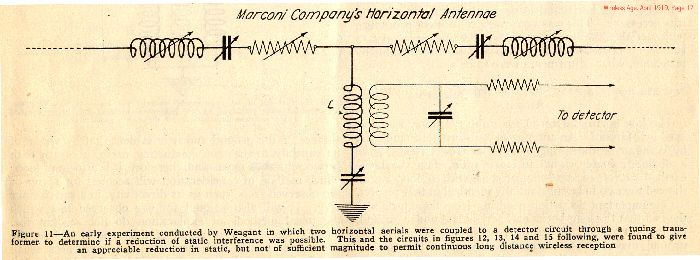
Page created January 14, 2004
We Need Your Help! Volunteer with Us.
Join our mission to preserve historic Camp Evans and teach the public about science and history.
Sign up to join our team of volunteers and start on your own mission today.
InfoAge Science & History Museums
2201 Marconi Road
Wall, NJ 07719
Tel: 732-280-3000
info@infoage.org
webmaster@infoage.org
